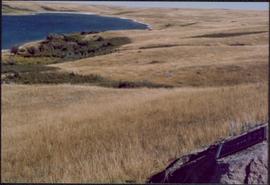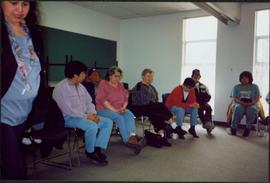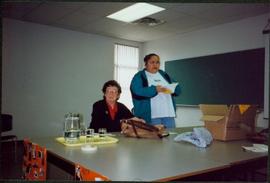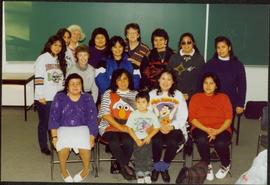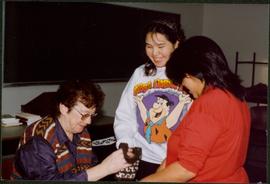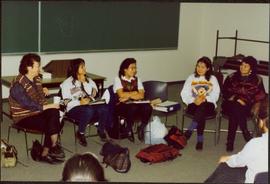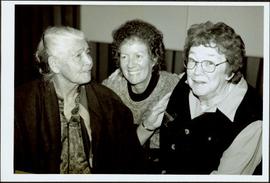File consists of a videocassette (VHS) recording of Justa Monk giving a talk to a UNBC Carrier Culture Course (First Nations Studies 163) on October 24, 1995.
Videocassette Summary
Context: Justa Monk speaks to students in the UNBC Carrier Culture Course (First Nations Studies 163)
Introduction: Justa Monk is seated at a table situated at the front of a lecture theatre (?) speaking in a lecture style that ended in a question-answer format with several students in the FNS 163 class. The videotaping does not commence from the beginning of the lecture as there is no introduction to Justa Monk by the instructor and there is no immediate indication as to who the instructor is.
Justa wrote his book because his elders requested him to, and his people requested him to share what he went through and what alcohol had done to him. So he thought about it. Throughout his leadership, many people talked with him about their alcohol problem and how they couldn’t get out of the trench they were in. He wrote the book to tell them that ‘yes’, they can get out of the trench and that ‘yes’, they can change. Other reasons why he wrote his book: when his people get into trouble, they often classify themselves as a ‘nobody’ – when they read his book, they see the trouble he went through: first, at young age, when he started drinking after he left residential school. Then as he grew, it got to point where he couldn’t control his drinking- where he was blacking out and didn’t remember why he was in jail. When he got drunk he was a fighter, even though he was small. He didn’t care. He would work everyday and fight every weekend. Growing up on reservation, there is no choice as to future and not much to do so many turn to booze. Every time a friend or relative had alcohol they would share it with their next closest friend or relative. In his family, his brother came over to the house to invite him to drink over-proof rum with him. He blacked out, killed his brother and spent time in jail. He was very suicidal. He didn’t want to live after what he did. His lawyer talked to him. Upon his release he thought he lost the respect and love of his family and his community. It surprised him that he was forgiven and that he had a future in his life. It was hard. It still bothers him after 29 years.
When he came back to his community the elders came to talk to him about his leadership qualities. He didn’t know what they were talking about. The elders told him that in past he made mistakes, but that he can iron out his mistakes and show his leadership and that’s what happened. He became band manager, then band manager and chief,and then chief and so forth. That is why he wrote that book.
‘Yes’, he listened to his elders, ‘yes’, he was a drunk, ‘yes' he made a mistake because of alcohol. He came out of his trench and became a leader. There is hope to change if there is a wish to change.
He also wrote his book because no one in his territory, except Mary John, had been able to share with non-Indians the way of life they lived - off the land. He grew up on an isolated reserve, and lived off the land. He didn’t understand English until he went to [Lejac] residential school. It’s really hard to make people understand today, what First Nations people were like in his day. In his family there were 11 of them. His father made something like 50 cents a day to support them all - it was really hard.
When Justa went to residential school, he didn’t know how to speak or understand English. His parents didn’t go to school at all. His Dad knew some English because he worked off reserve at a lodge. On his first day of residential school, he asked his brother why they were taking away his clothes. A priest smacked him and told him ‘he was not to use that language around here’. Residential school has done some harm, a lot of harm, to his people. On the other hand, he cannot totally criticize these schools as they disciplined some people – many people in leadership positions today grew up in residential school. Residential schools were told by the government to make assimilate the children and make a white person out of a brown person. He thinks they went about it the wrong way. That is where the frustrations of First Nations people come. You see and hear about abuse. His people are suffering from the consequences of the stupidity in the way they tried to make his people assimilate. Because of that, there is abuse going on amongst his people. Aside from that, he one of lucky ones to go home and retain language and culture: now he can live in 2 worlds – the world of the white man and the Indian world.
Culture-wise they were taught to respect. Mom was boss in house. If they didn’t do what mom said, dad would punish them but his parents wouldn’t lay a hand on the children. They taught children how to respect the land, and other people. They taught him how to use the land. Sophie Thomas, elder who does Indian medicine in Stoney Creek lives the belief that every time you take something from land you replace it with something. When Sophie takes things for Indian medicine she replaces it with tobacco.
He wonders if his people will ever have the opportunity again to hunt and fish anywhere they want. He doesn’t think so. When people started warring about the land there was a lot of bloodshed in the early 1900s before the Europeans came. His people worried that there were too many dead amongst the Indian people, and they had to do something about it. In 1921 they came up with the idea of potlatch as they needed peace amongst the people as there was too much bloodshed. To him ‘potlach’ means respect, love and sharing. If you’ve done something to wrong your neighbour instead of fighting, clans would call a potlatch right then and invite all. They would put the fighters in the centre and each were told no more fighting. This still goes on. There is also a potlatch for death of people. There are four clans in a potlatch: caribou, beaver, frog and bear (?)
A long time ago First Nations people fought for land but they had respect for land; that is why they had to protect the land and kill one another for it. If someone trespassed without permission, they could die. People talk about self-government today. The young generation of his people didn’t even know there was self-government amongst their own people, that they controlled their own people. They had no government programs, they were living off the land and controlling their own people. They used to have Watchmen, who looked after the community. The 1 and only person they had to answer to was the hereditary person, who overlooked the territory, their lands. So when someone did something they weren’t supposed to do, that person went in front of the hereditary person to receive a punishment. He was taught that boys weren’t even allowed to kiss a girl, without proving to her family that they were a good hunter and provider. If they did, they would be held up to all and embarrassed. They might be beaten if they still didn’t understand their punishment. They may also have been banished. No one would protect this person, not even their immediate family as everyone knew that the person did wrong and was receiving the correct punishment. His people had their own controls and justice system. Self-government - if you lived in late 1800s / early 1900s – was very different from how it is referred to nowadays. He wonders if leadership and his people really know what they are talking about when talking about self- government.
Land claims and the treaty process – he was told by his elders not to say land “claims” but rather the land “question”. Many people are scared about the land question. Different political parties say different things and people are getting really confused. The whole land question is referring to the fishing, hunting, burial, berry picking, fishing habitats: the grounds where his people used to make their living off the land – this is what the elders are talking about and want to protect. The clans are talking about traditional territories. Many people lived off the land until 1970, therefore their people are still living off the land. There are many traditional territories still out there.
He considers himself an inmate of Canada – a jail bird. When the Hudson’s Bay Co. first started, the government started to make reservations. They gave so many acres to First Nations people as ‘reserves’ and they put a number to each reserve. As they put people onto the reserves, they also ‘branded’ them with band numbers and put ‘guards’ over them – aka the “DIA”. His people had no input. They were given programs and free education etc and were now labeled by non-natives as bums who pay no tax and receive free programs – but they had no input.
You look at the Indian Act you can see that land doesn’t belong to his people. Even the reserve isn’t theirs. They don’t own anything, yet they are known as the First Nations, the First Peoples. They live in that little jailhouse. They receive their free programs and some are very beneficial to his people, but he wishes they had a say. Land claims are not dangerous. Justice must be cleared up. Once this is done there will be a big opportunity for their future children to have a better life. They must get this uncertainty out of the way. That’s what he’s trying to do. He believes they need a chance to have their say regarding things that are happening around them. To be able respect the culture they are from, and to recognize who they are they must clear the air. There is a lot of frustration out there, especially within the younger generation. He has been taught to have patience and respect. In the early ‘30s in Fort St. James, the dirty ‘30s, his dad taught him to share what provisions they had. People still thank Justa for that kindness of his parents. He believes starvation is coming due to dwindling resources and too many people. He says everyone must set aside their differences re: the land question and see what can be done to change it for the betterment of the children. If the government would deal with the land question openly and in fairness, it would be resolved. But they want to lie about things. You need to treat everyone fair. That is the way he sees the treaty process. He wants to get rid of the Indian Act and draft something that will be fair to everybody.
Kemano II (KII) is something no one follows up on anymore. In 1989 when he was general band manager, he went to court in Vancouver with many elders. The court threw them out. He fought KII so hard because he knew that when you kill the river (the Nechako), you kill all that is in it. When a river dies there is no more salmon. If the Nechako died, the Stewart River would die and then Stewart Lake would die too. And if the Nechako was gone the Fraser Rriver would be drained down. KII just looked at reversing the Nechako but it didn’t look at the affect it would have on other waterways. That’s why he fought so hard. Justa’s mandates a chief: 1) to get land claims on the table again; 2) to kill KII; 3) to get rid of the DIA office in PG; 4) to get education for their people. He fought KII not because they didn’t like Alcan – it was their way of life that was going down. There is not only salmon in the Nechako – there are many species which were feeding his people. He fought KII legally through funds from his people -
$1.3million. He is proud they made the decision not to go along with the project. This topic he touches upon briefly in his book.
[Note: It is very difficult to hear many of the students’ questions. Most questions as they are identified below are summaries of what was believed to have been said]
Q: How can he belong to 2 clans?
Justa: He belonged to mother’s frog clan when he was growing up. Then one day the caribou clan asked him to go out and invite people to their potlatch. During this potlatch he was asked to sit in middle between clans. The spokesperson for caribou clan said they were going to “buy” Justa Monk. One of the caribou elders said Justa’s father is a caribou and so they want him as a caribou and take him away from his mother’s frog clan. His dad was very happy about this, but his mother was upset. The beaver clan then planned a potlatch and asked him to invite people to their potlatch, and again he was asked to sit in the middle as they wanted to buy the other half of him. So he is also part of the beaver clan. He was bought out of respect due to his leadership qualities. He used to help his elders a lot ever since he was young and that is why his leadership was recognized.
Q: Where are your kids, and what clan are they?
Justa: They are at home. The kids belong to his wife’s clan – Caribou. He adopted 2 children: a daughter and a son.
Q: You want to look ahead, what do you want to bring with you?
Justa: You can’t turn back the clock and live off the land again. Some people don’t even understand their own language. To live off land, and do potlatch all the time – you can’t do it. These cultural events are disappearing. He wants to make his culture and the white culture work together in order to make it work for his young people. With technology the way it keeps going, his people have to get more education.
There is no chance for them to go back. With clear cutting, his people can’t even trap anymore. So it is better to set it up, so that Canadian and Indian culture can work together.
Q: How do you see the land question getting settled?
Justa: In traditional territories, there are only some places we can hunt for bear and dear. They hang out between willow and poplar trees. When logging we have to leave something for animals. If they don’t have shelter they won’t last long. In traditional territories, we need to leave those places alone so the animals can survive. We must all have a say in how the land can be used properly – it needs to be a join venture.
Q: If land claims are settled, people in the DIA would lose their jobs. Maybe this is why they are dragging their feet?
Justa: If land claims were settled, yes, 40-50,000 people might lose their jobs. The government would save a lot of money.
Q: How would you model your people’s government?
Justa: Don’t want to repeat something already done. For their money, they would chose the best way for them.
Q: re: logging [inaudible]
Justa: They are not going to clear cut. Selective logging has worked in past. The government is going to run into trouble by clear cutting. At Nakalak Lodge, if you look at both sides of hill in summer, you wouldn’t know it’s been logged because it was selective logged. You can’t even see skid roads. If it (destructive logging practice) keeps going the way it is now, there is going to be winds that are going to be damaging to us.
Q: re: spiritual practice as it relates to logging
Justa: There are certain areas in their territory where spiritual things happen and so these areas wouldn’t ever be touched. His elders would look at the territory and identify which areas are to be protected. You must involve grass roots people in the selection process. We don’t have medicine men and women they way the used to – they no longer exist.
Q: re: difference between statistics released by the government and those produced by Justa in his book. Justa: Don’t listen to what the government has to say. His people are not dummies, they just have nothing to do and are sitting around on reservation.
Q: Do you pay other people to build housing on reserve?
Justa: We build our own houses and have our own electricians. Once the land question is settled he thinks a lot of joint ventures can be developed that will get his people off welfare.
Q: When your traditional areas are under the administration of his own people, would there be restricted access to these areas by non Indian people?
Justa: He didn’t think so. We would need to develop how to use the land and how to share it. But there would have to be some controls over the land somehow so it wasn’t abused.
Q: There must still be a lot of hunting and trapping even if a person can’t live off land anymore
Justa: Yes, many people are still hunting and trapping.
Q: How do you think social problems for your people can be fixed?
Justa: On reservations or in the city we need to start teaching our children way of life their elders grew up with. Right now they have TV, drugs and alcohol and that is distracting them. His people have to make time for the children. He regrets bringing TV to reserve when he was band manager.
Q: Are there any female band leaders?
Justa: Yes. Like the BC Indian Chief – Wendy Grant, he nominated her. A long time ago no there were no female band leasers as the women were at home with their children. Men were more up front about leadership.
Q: It seems that the native community can heal itself. Non-native communities spend a lot of time trying to heal native community but from his readings he thinks native communities can heal itself.
Justa: Settling the land base is required. When he was band manager, he made 5 emergency trips- suicide related- in one day; so he believes healing and pride will come back when the land base is settled.
Q: In the Artic, people control hunting and fishing via co-ops.
Justa: His people control their own hunting by season. No one is trigger happy. No one shoots just to shoot.
Justa: He is currently working with Northwood to educate First Nations peoples and teach them about Northwood sawmills etc. He is also finding out trapping takes place so Northwood doesn’t log there.
[Extensive question/answer period ensues whereby logging and wood processing techniques, ventures and technology on reserve and off are discussed.]
Justa: He is now taking a rest from leadership as he had done it for 25 years. Now he is starting to understand the people around him as he was being brainwashed by government after having to deal with them for so many years.
The instructor thanks Justa and gathers up her class to take them to the First Nations Centre.
Tape ends.
